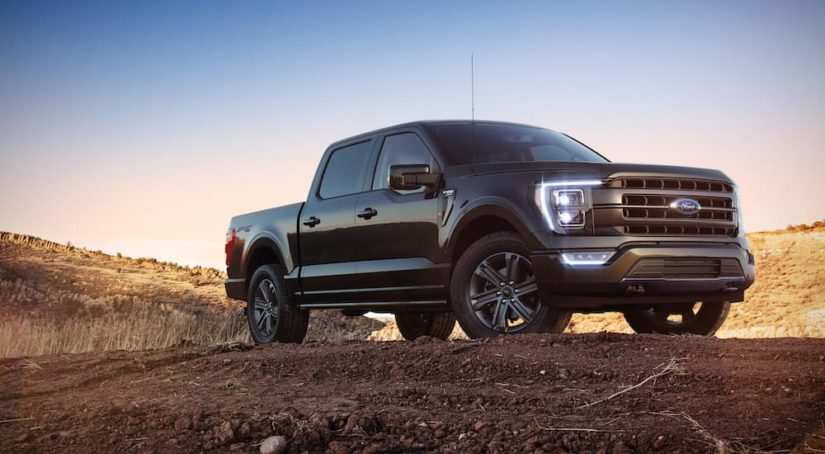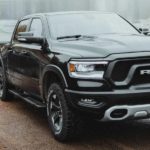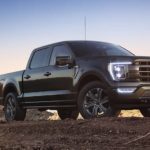Light-duty pickup trucks are still as popular as ever, and they don’t seem to be slowing down anytime soon in terms of wide market appeal. Those seeking out a specific work truck, though, are usually looking for a full-size pickup that can handle everything from payloads to trailering. Two of the most heated rivals in the space vying—for your hard-earned money—are the Silverado 1500 and F-150. These two trucks are best-sellers, especially throughout North America, and are often first-picks among those looking for reliable half-ton work trucks. But which option is better for those who need a new truck outfitted for day-to-day work purposes: the 2022 Ford F-150 vs. the 2022 Chevy Silverado 1500?
Do you opt for the long-running and highly respected F-150, or do you go for the always-dependable Chevy Silverado? This mainly boils down to what you’re willing to pay and how much you can save by opting for a fully featured, no-frills pickup. The good part about both trucks is that the work truck trims are actually the cheapest out of their respective trimlines.
Starting Prices on Work Trims
Technically, you can turn any of the Ford or Chevy light-duty pickup trims into a work truck, but both trucks have dedicated trims for the task. If you have a higher budget and don’t mind spending more on luxury-oriented features or off-road trims, then you can definitely do that. However, the work-focused trims are the starter trims. They’re designed to optimize weight so you can get the best payload and trailering out of them—along with rugged day-to-day performance. Check out the starting MSRP of the entry trims for both trucks below:
- 2022 Ford F-150 XL: $29,990
- 2022 Ford F-150 XLT: $36,630
- 2022 Chevy Silverado 1500 WT (Work Truck): $32,500
- 2022 Chevy Silverado 1500 Custom: $39,500
Right off the bat, you can see that the Silverado 1500 costs more. If saving every dime and dollar is important to you, this certainly puts those with a low budgetary ceiling in the F-150 camp. However, the thing to keep in mind is that the XL and WT trims are very, very, very basic. They don’t carry a lot of the amenities, nor the package options, that the other trims do. Remember, they’re designed chiefly for work purposes.
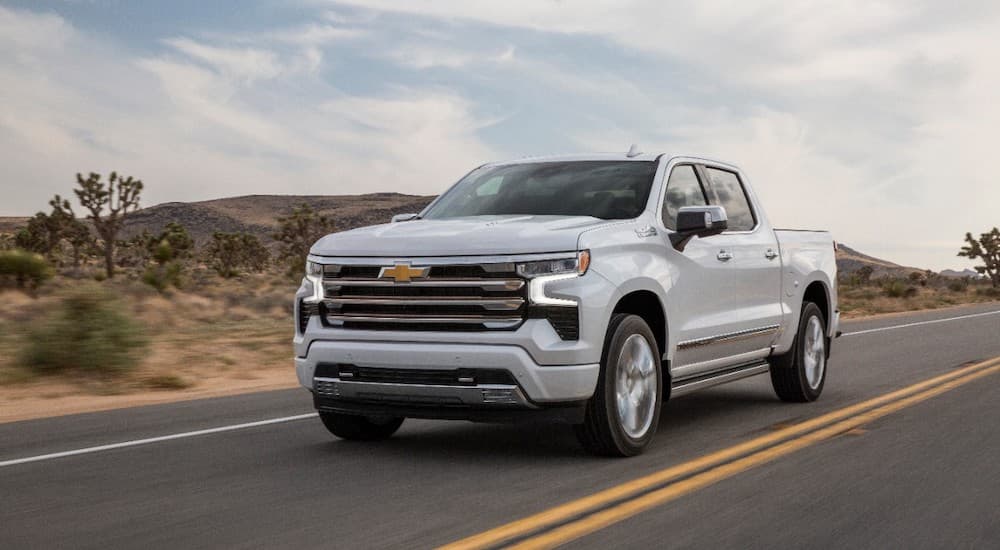
WT/XL: Pros, Cons, and Capabilities
For the entry-level prices, a lot of people are going to be concerned about work-related capabilities in these base models. In the case of the 2022 Silverado’s WT trim, it comes standard with the 2.7-L turbocharged 4-cylinder, but you can upgrade it to the 5.3-L EcoTec V8. It’s also fitted with an 8-speed automatic transmission. Unfortunately, the WT trim for the 2022 Silverado 1500 does not have the option of the 10-speed automatic transmission, nor the 3.0-L turbocharged Duramax 6-cylinder engine. The WT also cannot be outfitted with the much larger and more powerful 6.2-L EcoTec3 V8 engine. This severely limits the WT’s performance capabilities.
The upside to the WT trim is that you can get it in two or four-wheel drive format. You can have it outfitted with upgraded alternators at up to 220-amps—perfect for those who need to use the truck as an outdoor workstation for power tools and equipment. You can also have the four-wheel drive version outfitted with a 2-speed Autotrac transfer case—great for those who need to take the truck into quarries or off-road. The WT can top out at about 9,500 lbs of max conventional trailering and can max out its payload at just over 2,270 lbs1. You can outfit the WT in multiple cab formats, and with either a short, long, or regular-sized bed.
The 2022 F-150 XL is in a completely different league here. At the outset, it can also be outfitted in different cab formats, with short, long, or regular-sized beds. However, unlike the Silverado 1500’s WT trim, the F-150’s XL can make use of the full powertrain lineup that Ford has available for the 2022 F-150. The XL comes standard with a 3.3-L V6, but if you need more power you can opt for the 2.7-L EcoBoost V6, the 3.5-L EcoBoost V6, the 5.0-L V8, or the 3.5-L PowerBoost Turbo V6 Hybrid.
The availability of the different powertrains—along with the four-wheel drive and axle-upgrade with an electronic-locking rear differential—gives the F-150 XL a lot of leeway in its versatility. This means you can top out the XL’s max conventional trailering at up to 14,000 lbs with the 3.5-L EcoBoost V6. If you need the XL primarily for payload hauls, you can pair it with the 5.0-L V8 and achieve a max payload of 3,325 lbs2. As far as cons are concerned, the XL doesn’t have any glaring setbacks for someone looking for a reliable and customizable work truck that can scale to their needs.
Custom/XLT: Pros, Cons, and Capabilities
Just before you start getting into the more elaborate and specialty trims, the 2022 F-150 and 2022 Silverado 1500 have the XLT and Custom, respectively—two trims that offer a little bit more customization and variety than the XL and WT, but still fit well within the category of being work truck trims. The Custom, however, has fewer options than the WT when it comes to powertrain and drivetrain configurations, despite being more expensive than the WT. It comes standard with the turbocharged 2.7-L 4-cylinder and 8-speed transmission, but has no other available options when it comes to the engine or transmission.
Unlike the WT trim, you also don’t have access to the Autotrac transfer case with the Custom, even though you can get the trim itself in four-wheel drive. No alternative alternator options are available either, and unlike the WT, you don’t have access to features like the heavy-duty air filter or available skid plates. So what do you get with the Custom? Well, it comes standard with tinted glass, as well as 20-in aluminum wheels, LED taillights, and the Trailering Package—which includes everything you need to trailer right out of the gate. But without the other powertrain options, the Custom is limited to a payload capacity of approximately 2,270 lbs and a max conventional trailer rating of about 9,500 lbs.
The Ford F-150 XLT gives you a lot more to work with by comparison. Much like the XL trim, it comes with the 3.3-L V6, but you can still outfit the XLT with any of the powertrains that suit your needs, scaling up as necessary. Where it differs from the XL is that it comes with standard Ford Co-Pilot360 functions, including many passive and active safety features. Just like the XL, both trims come standard with a 10-speed automatic transmission, and the XLT can be configured in a four-wheel drive format.
The XLT also offers more interior luxury features, such as an optional leather-wrapped steering wheel, and available tailgate work surface and step functions. Those options aren’t available for the XL, even though both the XL and XLT share many of the same package add-on features. These include the Trailer Tow Package, Max Trailer Tow Package, and the Heavy-Duty Payload Package. If you needed the F-150 for towing, trailering, or hauling, then the utility packages are perfect accouterments, even if they cost a bit extra.
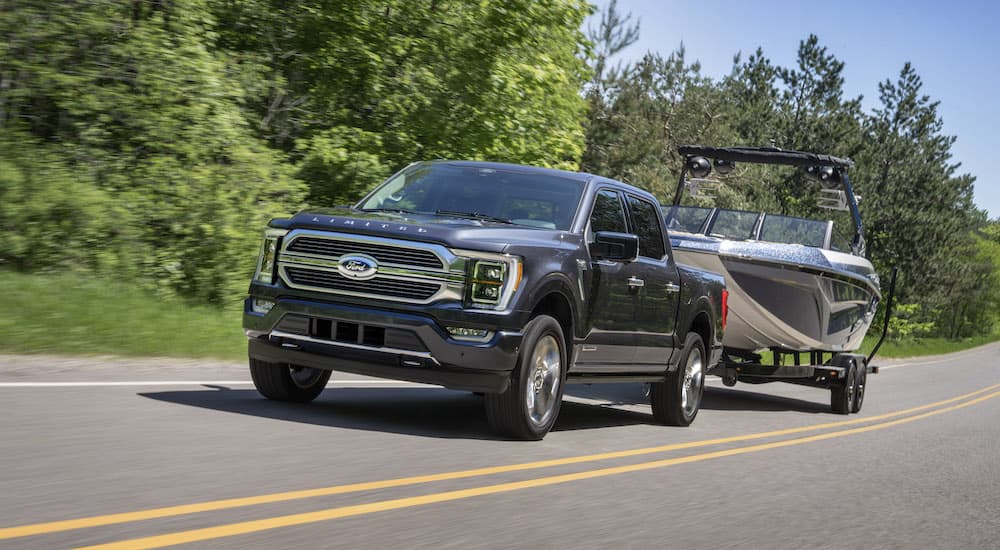
More for Less
When comparing the features, capabilities, and overall value of the work-focused trims between the 2022 Ford F-150 and 2022 Chevy Silverado 1500, it’s pretty apparent that the F-150 is the better option. While the Silverado WT and XL can both scale up as needed, the WT doesn’t have access to as many powertrain options as the XL. And, while you have access to more comfort amenities and infotainment features with the Silverado’s Custom trim, it loses out on access to configurations and features that many truckers might actually prefer having on their worksites—as opposed to leather steering wheels and a souped-up audio system. It’s rather clear that, among half-ton pickup trucks designed for work, the F-150 definitely gives you more—for a lower starting price.
